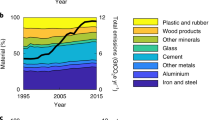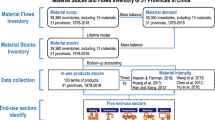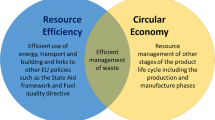Abstract
China–Japan trade has developed rapidly over the past four decades. Studying the hidden environmental impact of China–Japan trade can help policy makers identify which categories of import and export commodities exert major impacts on the country’s environment. In this paper, we use material flow analysis and hidden flow analysis to identify products with the largest material flows, hidden flows, and value flows in China–Japan trade between 1993 and 2015. We summarize the analysis results of five major types of materials. During this 23-year period, the total volume of material flows exported by China changed little from 33.0 GT to 32.7 GT, a decline of 0.96%. The total volume of imported material flows increased substantially from 12.5 GT to 24.9 GT, a surge of 98.74%. The total volume of hidden flows imported by China also grew dramatically from 44.7 GT to 123.2 GT, an increase of 175.32%. The total volume of exported hidden flows increased from 34.3 GT to 74.6 GT, a 116.97% jump. The largest proportion of material flow export product from China was coal, including bitumen; the largest proportion of material flow export products from Japan were iron filings and iron-containing scrap; the largest proportion of hidden flow import products from China were precious metals; and the largest proportion of hidden flow import products from Japan were iron alloys.
Access this chapter
Tax calculation will be finalised at checkout
Purchases are for personal use only
Similar content being viewed by others
References
Jomo KS, Rudiger A (2009) Trade liberalization and economic development. Science 323:211–212
JETRO (2015) JETRO survey: analysis of Japan-China trade in 2014. http://www.jetro.go.jp/en/news/2015/20150225183-news. Accessed 10 Nov 2014
Eurostat (2001) Economy–wide material flow accounts and derived indicators: a methodological guide. Eurostat, Luxembourg
Moriguchi Y (2002) Material flow analysis and industrial ecology studies in Japan. In: Ayres RU, Ayres L (eds) A handbook of industrial ecology. Edward Elgar Publishers, Cheltenham
Schandl H, West J (2010) Resource use and resource efficiency in the Asia-Pacific region. Glob Environ Change 20(4):636–647
Wang H, Hashimoto S, Moriguchi Y, Yue Q, Lu Z (2012) Resource use in growing China: past trends, influence factors and future demand. J Ind Ecol 16(4):481–492
Ma F, Wang H, Zhu B, Chen D, Dai H, Wang J, Zhao S, Yue Q, Zhang G, Xie Y, Geng Y, Du T (2018) Material footprint of a fast-industrializing region in China, part 1: exploring the materialization process of Liaoning Province. Resour Conserv Recycl 134:228–238
Wang H, Dai H, Dong L, Xie Y, Geng Y, Yue Q, Ma F, Wang J, Du T (2018) Co-benefit of carbon mitigation on resource use in China. J Clean Prod 174:1096–1113
Chen W-Q, Graedel TE (2015) In-use product stocks link manufactured capital to natural capital. Proc Nat Acad Sci USA 112:6265–6270
Yue Q, Wang HM, Gao CK, Du T, Liu LY, Lu ZW (2015) Resources saving and emissions reduction of the aluminum industry in China. Resour Conserv Recycl 104:68–75
Liu G, Bangs CE, Müller DB (2012) Stock dynamics and emission pathways of the global aluminium cycle. Nat Clim Change 3:338–342
Chen WQ, Graedel TE, Nuss P, Ohno H (2016) Building the material flow networks of aluminum in the 2007 US economy. Environ Sci Technol 50:3905–3912
United Nations (2018) United Nations Commodity Trade Statistics Database. http://comtrade.un.org/. Accessed July 2018
Dittrich M, Bringezu S (2010) The physical dimension of international trade. Ecol Econ 69:1838–1847
Dittrich M, Bringezu S, Schütz H (2012) The physical dimension of international trade, part 2: indirect global resource flows between 1962 and 2005. Ecol Econ 79:32–43
Acknowledgements
This research was supported by College Students’ Innovation and Entrepreneurship Project of Northeastern University of China (180081), National Natural Science Foundation of China (41871204, 41401636, and 71403175) and Fundamental Research Funds for the Central Universities (N172504026).
Author information
Authors and Affiliations
Corresponding author
Editor information
Editors and Affiliations
Rights and permissions
Copyright information
© 2019 Springer Nature Switzerland AG
About this paper
Cite this paper
Wang, H., Zhao, X., Zhang, Z., Li, S., Yuan, J. (2019). Material Flows Embodied in China–Japan Trade. In: Sugumaran, V., Xu, Z., P., S., Zhou, H. (eds) Application of Intelligent Systems in Multi-modal Information Analytics. MMIA 2019. Advances in Intelligent Systems and Computing, vol 929. Springer, Cham. https://doi.org/10.1007/978-3-030-15740-1_49
Download citation
DOI: https://doi.org/10.1007/978-3-030-15740-1_49
Published:
Publisher Name: Springer, Cham
Print ISBN: 978-3-030-15738-8
Online ISBN: 978-3-030-15740-1
eBook Packages: Intelligent Technologies and RoboticsIntelligent Technologies and Robotics (R0)




